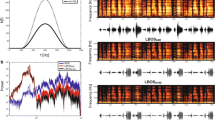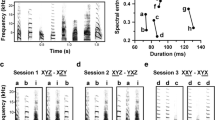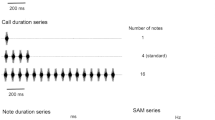Abstract
-
1.
Auditory responses in the zebra finch (Taenopygia guttata) song-system nucleus HVc were assessed at 54 recording sites by 3 different methods: discriminated action potentials; excitatory summed responses; and excitatory minus inhibitory summed responses. Four standard stimuli were presented at each site: the bird's own song; this song reversed; a conspecific song; and a noise burst. Responses were quantified by calculating a relative response index that partitioned the response, to provide a response profile, across the stimuli.
-
2.
Regardless of analysis method, the strongest response was most often to the bird's own song (78–82%, depending on method). The predominant rank order of response strength across the remaining three stimuli was conspecific song > reversed song > noise.
-
3.
The distribution of relative response magnitude was sensitive to analysis method. Discriminated spikes captured the heterogeneity of HVc neurons, whereas the excitatory summed responses reflected the overall trends more consistently. When inhibition was subtracted from excitation in the summed responses, the variance of the relative responses increased, but this method presented some problems for statistical analysis.
-
4.
A small sample of neurons in other forebrain auditory areas was used for comparative analyses. At these recording sites, the bird's own song did not consistently elicit the best response and there were generally smaller differences in the relative responses to the four stimuli. The smaller degree of stimulus selectivity among these cells resulted in less sensitivity to differences in the assessment methods.
Similar content being viewed by others
Abbreviations
- BOS :
-
Bird's own song
- CON :
-
conspecific song
- DLM :
-
medial nucleus of the dorsolateral thalamus
- E-only SR :
-
excitatory summed response
- E-I SR :
-
excitation minus inhibition summed response
- HVc :
-
caudal nucleus of ventral hyperstriatum (also called “high vocal center”)
- L-MAN :
-
lateral magnocellular nucleus of the anterior neostriatum
- RA :
-
Robust nucleus of the archistriatum
- REV :
-
reverse bird's own song
References
Bonke BA, Bonke D, Scheich H (1979) Connectivity of auditory forebrain nuclei in the Guinea Fowl (Numida meleagris). Cell Tissue Res 200: 101–121
Bottjer SW, Halsema KA, Brown SA, Miesner EA (1989) Axonal connections of a forebrain nucleus involved with vocal learning in zebra finches. J Comp Neurol 279: 312–326
DeVoogd TJ, Nottebohm F (1981) Sex differences in the dendritic morphology of a song control nucleus in the canary: A quantitative Golgi study. J Comp Neurol 196: 309–316
Doupe AJ, Konishi M (1991) Song-selective auditory circuits in the vocal control system of the zebra finch. Proc Natl Acad Sci USA 88: 11339–11343
Doupe AJ, Konishi M (1991) Song-selective auditory neurons emerge during vocal learning in the zebra finch. Soc Neurosci 18: 527
Fortune ES, Margoliash D (1992) Cytoarchitectonic organization and morphology of cells of the Field-L complex in male zebra finches (Taenopygia guttata). J Comp Neurol 325: 388–404
Fortune ES, Margoliash D (1995) Parallel pathways and convergence onto HVc and adjacent neostriatum of adult male zebra finches (Taenopygia guttata). J Comp Neurol 360: 413–441
Katz LC, Gurney ME (1981) Auditory responses in the zebra finch's motor system for song. Brain Res 211: 192–197
Kelley DB, Nottebohm F (1979) Projections of a telencephalic auditory nucleus — Field L — in the canary. J Comp Neurol 183: 455–470
Knipschild M, Dörrscheidt GJ, Rübsamen R (1992) Setting complex tasks to single units in the avian auditory forebrain. I. Processing of complex artificial stimuli. Hearing Res 57: 216–230
Lewicki MS, Konishi M (1995) Mechanisms underlying the sensitivity of songbird forebrain neurons to temporal order. Proc Natl Acad Sci USA 92: 5582–5586
Margoliash D (1983) Acoustic parameters underlying the responses of song-specific neurons in the white-crowned sparrow. J Neurosci 3: 1039–1057
Margoliash D (1986) Preference for autogenous song by auditory neurons in a song system nucleus of the white-crowned sparrow. J Neurosci 6: 1643–1661
Margoliash D, Fortune ES (1992) Temporal and harmonic combination-sensitive neurons in the zebra finch's HVc. J Neurosci 12: 4309–4326
Margoliash D, Konishi M (1985) Auditory representation of autogenous song in the song system of white-crowned sparrows. Proc Natl Acad Sci USA 82: 5997–6000
Margoliash D, Fortune ES, Sutter ML, Yu AC, Wren-Hardin BD, Dave A (1994) Distributed representations in the song system of oscines: Evolutionary implications and functional consequences. Brain Behav Evol 44: 247–264
Nixdorf BE, Stephen SD, DeVoogd TJ (1989) Morphology of Golgi-impregnated neurons in hyperstriatum ventralis, pars caudalis in adult male and female canaries. J Comp Neurol 284: 337–349
Nottebohm F, Kelley DB, Paton JA (1982) Connections of vocal control nuclei in the canary telecephalon. J Comp Neurol 207: 344–357
Nottebohm F, Stokes TM, Leonard CM (1976) Central control of song in the canary, Serinus canarius. J Comp Neurol 165: 457–486
Schäfer M, Rübsamen R, Dörrscheidt GJ, Knipschild M (1992) Setting complex tasks to single units in the avian auditory forebrain. II. Do we really need natural stimuli to describe neuronal response characteristics? Hearing Res 57: 231–244
Scheich H (1990) Representational geometries of telencephalic auditory maps in birds and mammals. In: Finlay BL, Innocenti G, Scheich H (eds) The neocortex: ontogeny and phylogeny. Nato Workshop, Plenum Press, New York, pp 119–136
Smith DV, Travers JB (1979) A metric for the breadth of tuning of gustatory neurons. Chem Sens and Flav 4: 215–229
Sossinka R, Böhner J (1980) Song types in the zebra finch Peophila guttata castanotis. Z Tierpsychol 53: 123–132
Sutter M, Margoliash D (1994) Global dynamical response to autogenous song in the zebra finch HVc: Implications for sensorimotor function. J Neurophysiol 72: 2105–2123
Travers JB, Smith DV (1979) Gustatory sensitivities in neurons of the hamster nucleus tractus solitarius. Sens Processes 3: 1–26
Vicario DS, Yohay KH (1993) Song-selective auditory input to a forebrain vocal control nucleus in the zebra finch. J Neurobiol 24: 488–505
Volman SF (1993) Development of neural selectivity for birdsong during vocal learning. J Neurosci 13: 4737–4747
Volman SF (1995) Neurophysiological evidence for song discrimination in songbird nucleus HVc. Soc Neurosci Abstr 21: 958
Williams H (1985) Sexual dimorphism of auditory activity in the zebra finch song system. Behav Neural Biol 44: 470–484
Author information
Authors and Affiliations
Rights and permissions
About this article
Cite this article
Volman, S.F. Quantitative assessment of song-selectivity in the zebra finch “high vocal center”. J Comp Physiol A 178, 849–862 (1996). https://doi.org/10.1007/BF00225832
Accepted:
Issue Date:
DOI: https://doi.org/10.1007/BF00225832




